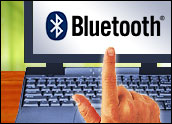
Bluetooth just got faster and its lobbyists are claiming the technology is moving full speed ahead with a new three-year road map.
The Bluetooth Special Interest Group (SIG) today announced the adoption of Bluetooth Core Specification Version 2.0 + Enhanced Data Rate (EDR), which is designed to improve the technology.
SIG is betting that tripling the current data rates and lowering the power consumption will improve the Bluetooth experience for users running multiple devices simultaneously and transferring large data files via more bandwidth.
“The motivation behind 2.0 + EDR was to improve existing usage scenarios which require increased data throughput, like streaming CD-quality audio, digital image transfer and laser printing,” Dr. Michael Foley, executive director of the Bluetooth SIG, said.
“Now manufacturers can update to the latest Bluetooth specification to fit the demands of consumers for their particular product — and the user will get a better Bluetooth experience,” Foley said.
Headed in Right Direction
The Bluetooth enhancements come along with a three-year road map outlining a series of improvements to the specification designed to help manufacturers plan.
Mike Disabato, senior analyst at the Burton Group, told TechNewsWorld that the road map has Bluetooth headed in the right direction.
“It’s not only the road map that is significant, but some of the other things they are doing with it, like getting more into compliance and certification testing than they have in the past,” Disabato said.
The road map is a result of collaboration between SIG’s membership and staff to address future market demands, according to Foley. The road map is supposed to define the technology’s place in the wireless world.
“We don’t believe there is a one-size-fits-all wireless technology and want to clearly outline Bluetooth technology’s direction and core competencies,” Foley said.
The UWB Story
Bluetooth media stories typically mention competition from Ultra Wide Band (UWB) technologies from the IEEE. So how will Bluetooth compete with UWB?
“Compete with what?” Disabato asks. “You show me one cell phone or PDA manufacturer that’s putting UWB chips in.”
“Once we have some standards and some product and a direction from IEEE working group, then we’ve got something to talk about,” he said. “Right now we’re comparing promises with products and that’s never fair.”
Addressing Tough Issues
Beyond the speed and power consumption issues addressed in the latest spec, SIG plans to release a new version next year to further enhance the usability of multi-device scenarios and power consumption and improve overall security. Quality of service enhancements are also planned for next year.
By 2006, SIG plans to update the spec again to continue improvements on usability, security and performance. Multi-cast capabilities are planned to allow the same messages to be sent to multiple devices simultaneously. And performance enhancements will increase the range to about 100 meters.
The focus on security is something that Disabato likes to see. In fact, hesaid Bluetooth’s three biggest challenges are security, security andsecurity.
“They absolutely, positively have to convince enterprises, and even more so consumers, over time that the security problem’s been fixed,” he said. “The road map addresses that need.”











































